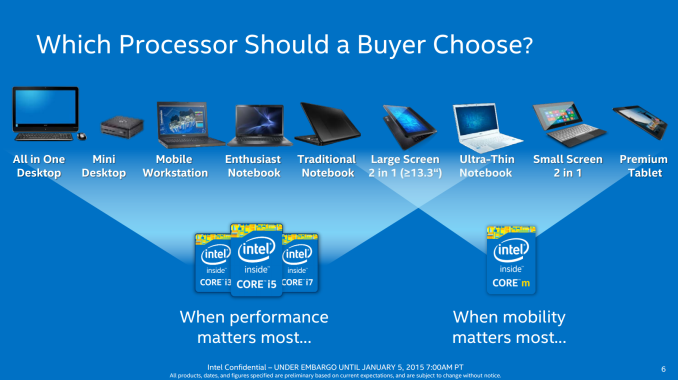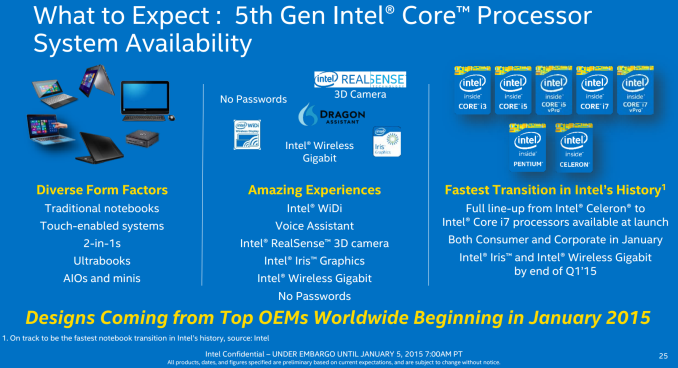Intel Releases Broadwell-U: New SKUs, up to 48 EUs and Iris 6100
by Ian Cutress on January 5, 2015 10:00 AM ESTFitting in With Core M
The staggered release of Broadwell is nothing new. Previous releases from Intel has seen them pick a particular market and aim at that first, whether it be tablet, mobile devices, ultrabooks or desktops, with the rest to follow. Core M, Intel’s 4.5 W ‘Broadwell-Y’ part, has been in the market for over a month with designs such as the Lenovo Yoga 3 Pro, although the number of SKUs available as well as worldwide distribution has been relatively slow, with the designs featuring Core M being expensive in terms of casual computing and more premium upgrades. Broadwell-U changes this by opening up the power envelope, and as such Intel sees the market at follows:
The Broadwell-U processors from Intel are aiming to give enough performance from AIO desktop systems to mini desktops, premium mobile applications all through to large 2-in-1s. There is some overlap with Core M, particularly with the 7.5W cTDP down elements of the range, but the interesting element will be pricing. The Celerons come in around $100, with the Pentium at $160, but then it gets expensive for Broadwell-U. $275 to $315 covers all the i3 and i5 parts both at 15W and 28W, ending with $393/$426 for the i7 parts. Further to my efficiency comments above, on paper at least the i5-5350U or i5-5250U would seem the most interesting processors of the bunch.
Release Dates
In our conference call with Intel, it was clear that these CPUs are shipping to their partners today. Throughout CES there will be a number of manufacturers announcing their products, and as per the norm Intel allows the partners to introduce their own products, rather than showing examples of where Broadwell-U fits in. However, because Broadwell-U is designed to be pin-compatible with Haswell-U, we might see some manufacturers purely re-releasing some of their designs with the newer CPU and a firmware update. Nevertheless, Intel is expecting OEM systems with Broadwell-U to start shipping in North America within the month. Designs with Iris graphics, or those featuring Intel based WiGig connectivity, will be more towards the end of Q1. Overall Intel is tracking ‘hundreds of designs’ involving Broadwell, indicating that it will be a significant push to bring 14nm to the market.












85 Comments
View All Comments
III-V - Monday, January 5, 2015 - link
Quads are Broadwell-H. I think those come in Q2.stephenbrooks - Tuesday, January 6, 2015 - link
H! What is it with Intel and the random letters of late? I thought at first they corresponded to TDP levels with later in the alphabet being lower. Now it seems they're for variants of the same architecture used with different numbers of cores, GPU cores and turbo/thermal limit.Pork@III - Monday, January 5, 2015 - link
Only two processor cores for number leading Core i7-5650U. Intel sucks! Wait for Skylake. If with a Skaylake exposed so sucks,I will unsubscribing Intel from my portfolio - forever!yvizel - Monday, January 5, 2015 - link
Oh NO! What would Intel do without your portfolio subscription??Someone PLEASE call Intel ASAP!
p1esk - Monday, January 5, 2015 - link
You made me laugh :-)maroon1 - Monday, January 5, 2015 - link
LOLCan you name any other CPU with 15w TDP that can match Core i7-5650U ?
In fact Core i7-5650U should probably even beat most of AMD 35w chips. Number cores doesn't really matter.
III-V - Monday, January 5, 2015 - link
It's their U series. Those SKUs target lower power -- quad cores aren't suitable for that. It's likely that with the power constraints, a quad core design wouldn't offer a whole lot more performance than a dual core.kenansadhu - Monday, January 5, 2015 - link
U-class of Intel mobile processors never had quad core, if I'm not mistakenaratosm - Monday, January 5, 2015 - link
HD6100 still lacks eDRAM. The performance improvement from haswell will be marginal since the biggest problem with HD5100 has been memory bottleneck.TiGr1982 - Monday, January 5, 2015 - link
Maybe DDR3-1866 may help a little bit for 48 EU GPUs (vs DDR3-1600 before).But indeed, without eDRAM ("Crystallwell"), 1866 is still not enough, presumably.